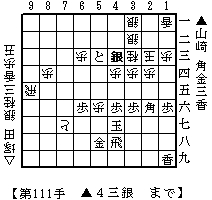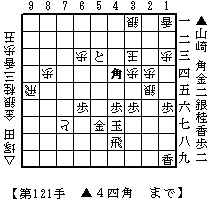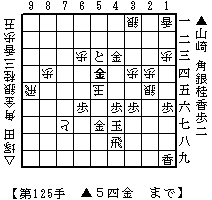On May 21, 2006, NHK(Japan Broadcasting Corp.) aired Tsukada 9dan vs Yamazaki 6dan and the game was ended with Miyakozume(Mate in the capital) which is very rare in a real game. In Tsumeshogi, Miyakozume is one of the themes of creation. Miyako means the capital. Since the square of 5e is the very center of the shogi board which is associated with the capital, a mated King on 5e is called Miyakozume.
 The first diagram is the position when the first player Yamazaki dropped his Silver on 4c as the 111st move. This was a threatmate with his rich pieces in hand such as a Bishop, three Golds and a lance . If Gote(White, upper player of the diagram) neglect it, then there were mate to begin with Sx3b= or Sx3d+ as followings;
The first diagram is the position when the first player Yamazaki dropped his Silver on 4c as the 111st move. This was a threatmate with his rich pieces in hand such as a Bishop, three Golds and a lance . If Gote(White, upper player of the diagram) neglect it, then there were mate to begin with Sx3b= or Sx3d+ as followings;
Sx3b= Sx3b G*2b Kx2b S*3a Kx3a G*4b K-2a Gx3b Kx3b B*4a K-2a S*3b K-1b G*2c(mate)
Sx3b= Kx3b G*4c K-2a S*3b Sx3b Gx3b Kx3b B*4a K-2a S*3b K-1b G*2c(mate)
Sx3b= Kx3b G*4c K-2c Gx3c Kx3c G*4c K-2b G*3c K-2a B*3b Sx3b Gx4c-3b K-1b S*2c(mate)
Sx3d+ Kx3d L*3e K-2c B*3d K-2b G*2c Sx2c Bx2c+ Kx2c S*3d K-1b G*2c K-2a G*2b Sx2b Gx2b Kx2b Sx3c+ K-2a S*3b K-1b +S-2c(mate)
The real proceeding of the game was like this.
P-5g+ Gx5g S*2e(2nd diagram)
 S*2e prevented Gote's King from being mated to begin with Sx3d+ only. So Gote's King should have been mated to begin with Sx3b=. But because of Gote's pawn sacrifice of P-5g+, Sente got a refreshing sequence with Bishop sacrifice to mate Gote's King. After the second diagram, the real proceeding was like this.
S*2e prevented Gote's King from being mated to begin with Sx3d+ only. So Gote's King should have been mated to begin with Sx3b=. But because of Gote's pawn sacrifice of P-5g+, Sente got a refreshing sequence with Bishop sacrifice to mate Gote's King. After the second diagram, the real proceeding was like this.
Sx3b= Kx3b G*4c K-2c G-3c Kx3c Bx4d(3rd diagram)

Without Gote's pawn sacrifice of P-5g+, Sente's Gold should have stayed on 5h and Sente's pawn on 6f should have been floating. This impressive Bishop sacrifice should have been impossible without it. After the 3rd diagram, the real proceeding was like this.
Kx4d G*4c K-5e G*5d(mate, 4th diagram)
 Yamazaki won the game with 125 moves at the 4th diagram. Tsukada did not resign until his king was mated on 5e. Professional players usually resign a game several moves before their King is mated. I think Tsukada intended to show Miyakozume on TV when he saw he had no hope to win the game around the first diagram and that's why he sacrificed his pawn by P-5g+ which enabled for Gote's King to be mated on 5e.
Yamazaki won the game with 125 moves at the 4th diagram. Tsukada did not resign until his king was mated on 5e. Professional players usually resign a game several moves before their King is mated. I think Tsukada intended to show Miyakozume on TV when he saw he had no hope to win the game around the first diagram and that's why he sacrificed his pawn by P-5g+ which enabled for Gote's King to be mated on 5e.
i just read a result from the US GO Congress that a 7dan amateur beat a 7dan pro. there is something very wrong with this, this teen has not had the atvantage of a pro go school where as the 7P has. this begs the question what use is a school if someone whom doesn't learn from one can beat someone whom does. this brings to the question for here if any how many amateur shogi players have beat top ranked pros not like habu san level players but 9,8,7 dan pros
Posted by: thomas giles | August 21, 2006 at 04:49 AM
I thought only Segawa 4dan who used be an ama player beat the said level of pro player. He won a game of Gingasen against Kubo 8dan when he was an ama.
Posted by: takodori | August 21, 2006 at 06:23 PM
takodori i went to the site in the above
both of the Osama'S where the carature for Jade very disappointing
in all of the shogi hands that i have seen there is only one with the 玉 and this is the shogi play whom plays sente the gote player has only the 王.
in the above site that you have directed us to the shogi playing board has 玉 for both sides.
historicly i understand that in nippon feudal times the kings could not face each other across the battle field so a prince would face the shogun hence the two 王, 玉
Posted by: thomas giles | August 30, 2006 at 05:08 AM
Thomas, thanks for your comment.
Since I'm not a historian, I do not know much about the origin of 王、玉. But I just like to point out the fact that both 玉 are used in almost all shogi diagrams in paper medium such as books, magazines and newspapers in Japan.
Posted by: takodori | August 30, 2006 at 01:19 PM